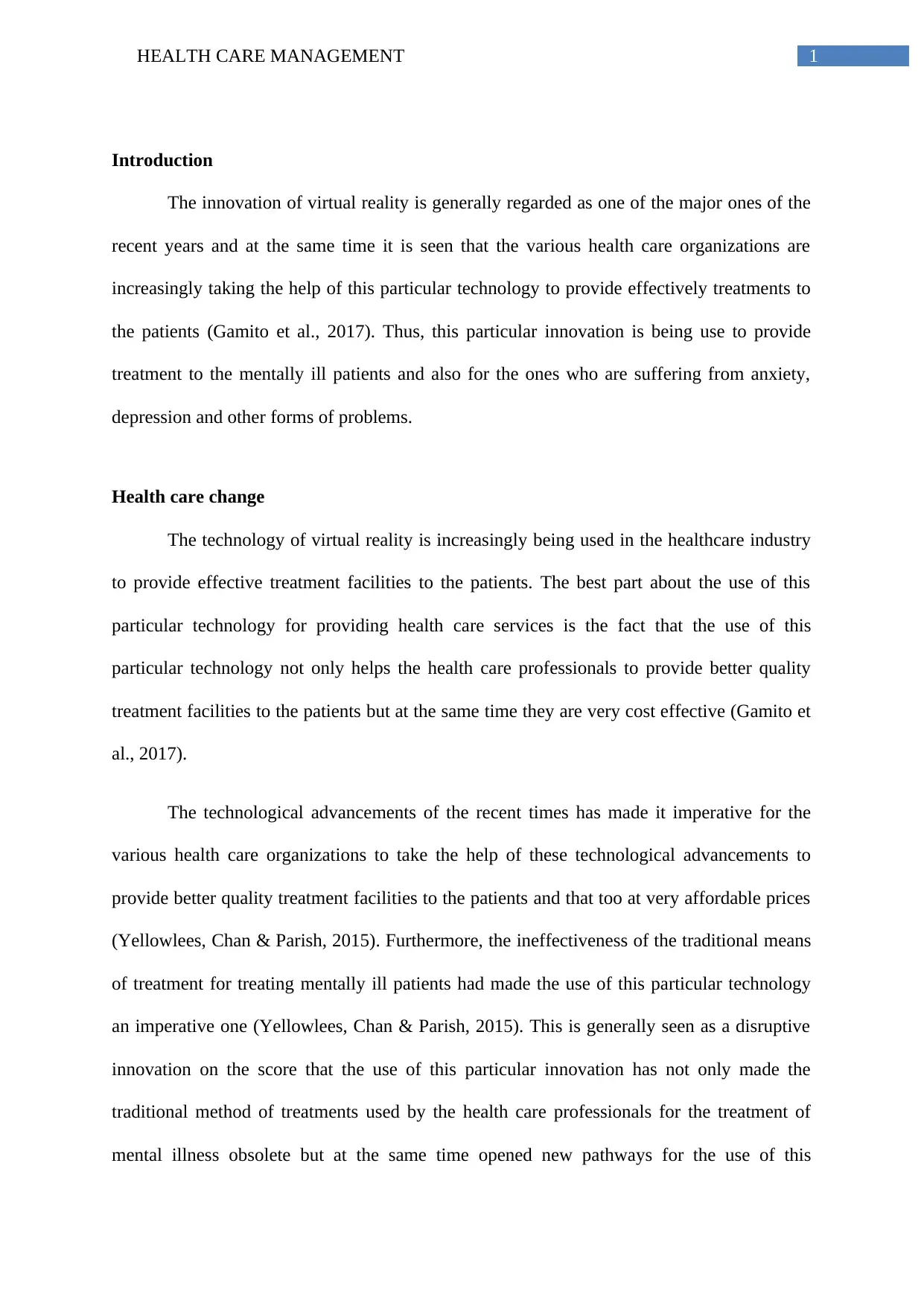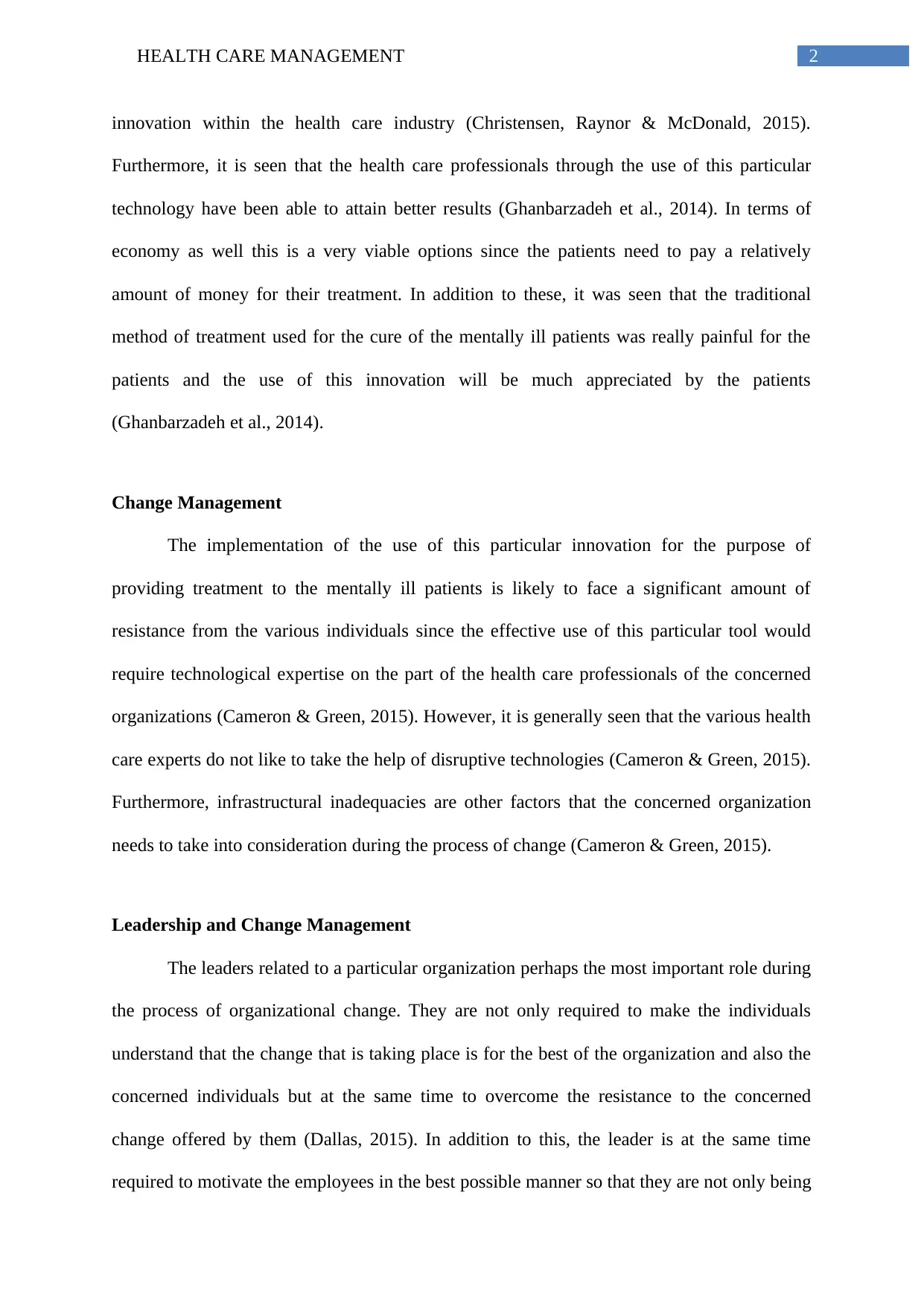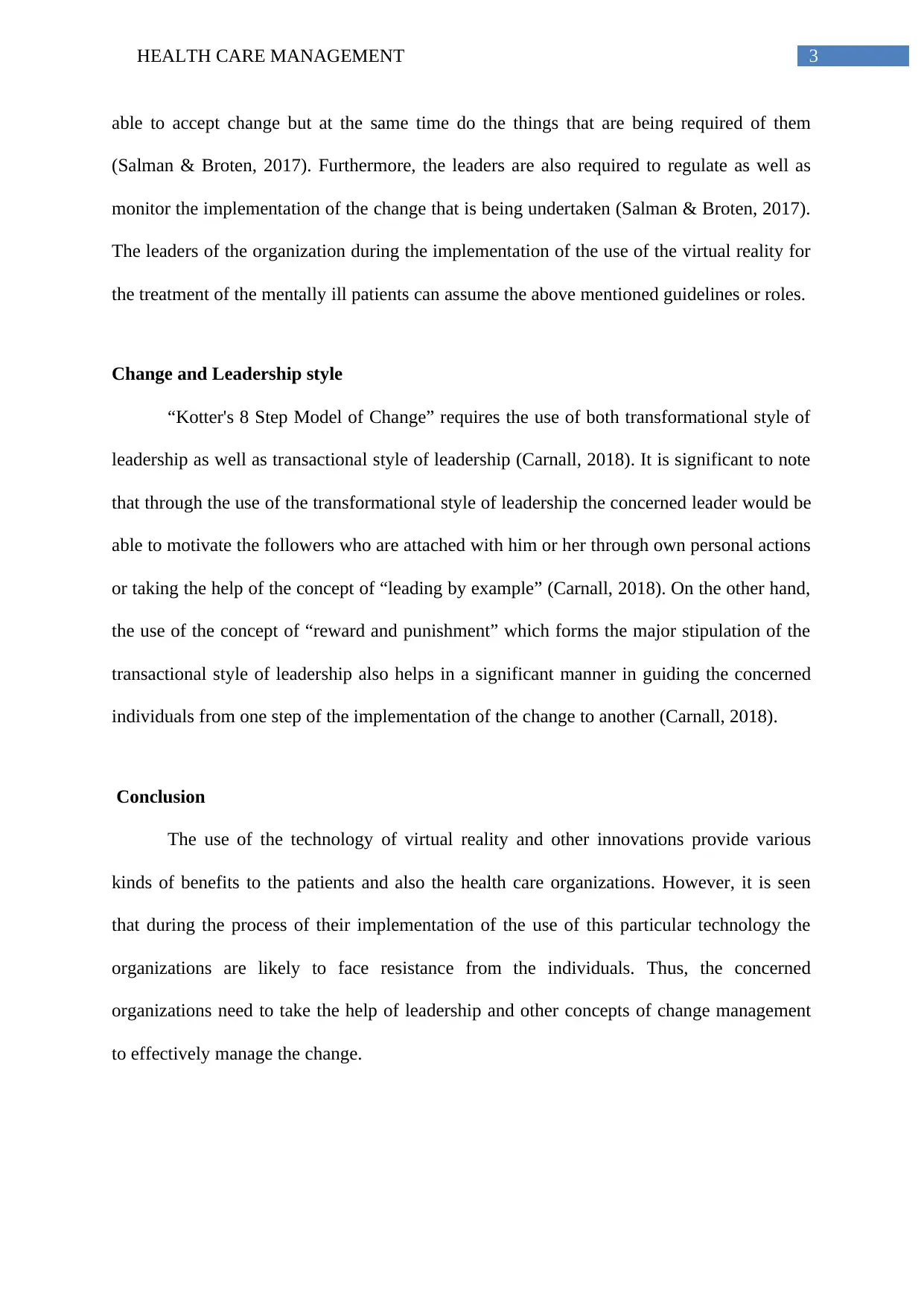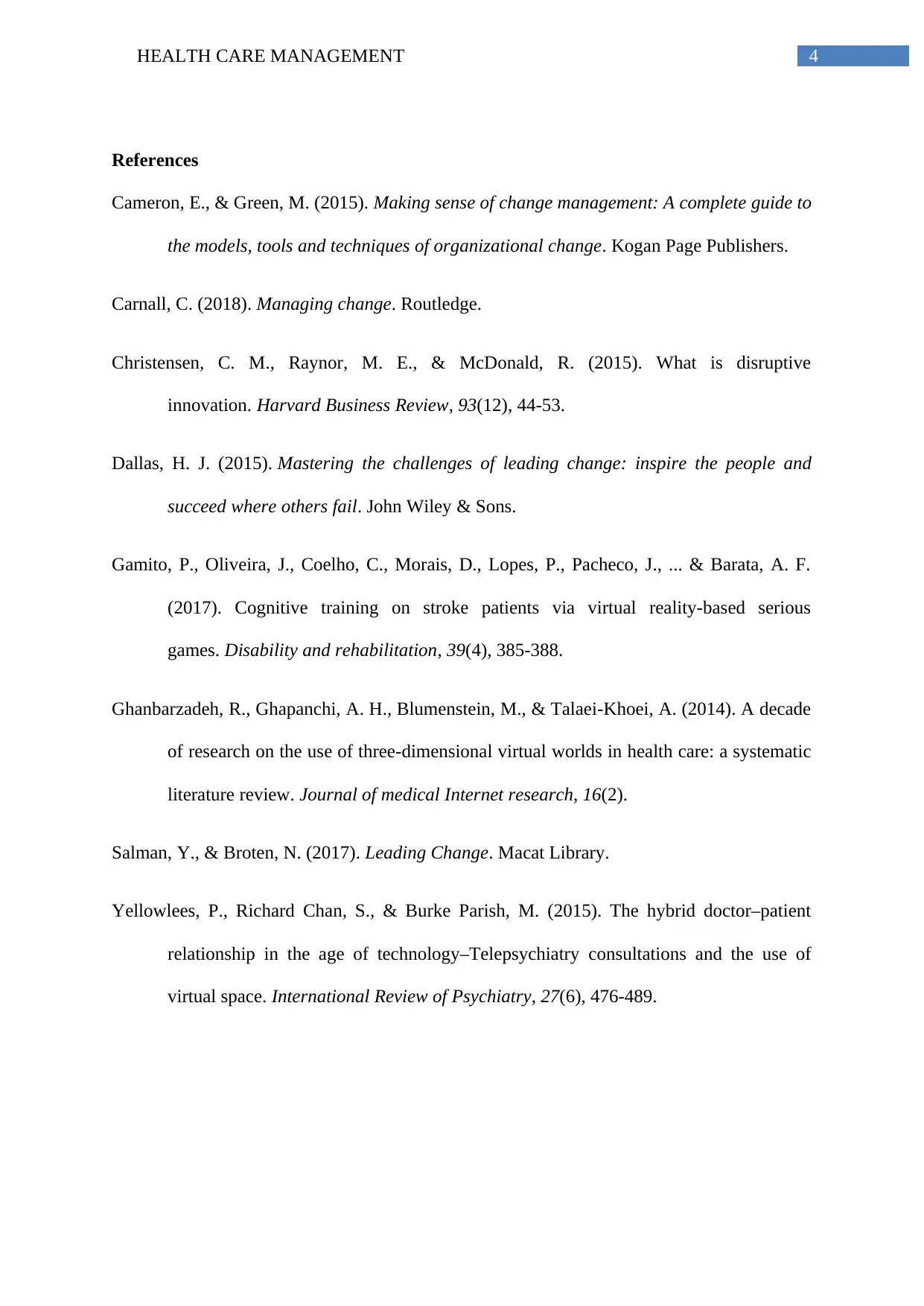Implementing Virtual Reality in Health Care: Change Management
VerifiedAdded on 2023/06/08
|5
|1310
|165
Essay
AI Summary
This essay examines the disruptive innovation of virtual reality in healthcare management, particularly for treating mental health patients. It highlights the cost-effectiveness and improved patient outcomes compared to traditional methods. The essay discusses potential resistance to change from healthcare professionals due to required technological expertise and infrastructural challenges. It emphasizes the crucial role of leadership in managing change, motivating employees, and regulating implementation using Kotter's 8-Step Model, incorporating both transformational and transactional leadership styles. The conclusion underscores the benefits of virtual reality while stressing the importance of effective change management strategies to overcome resistance and ensure successful adoption.

Running head: HEALTH CARE MANAGEMENT
Health Care Management
Name of the Student:
Name of the University:
Author’s Note:
Health Care Management
Name of the Student:
Name of the University:
Author’s Note:
Paraphrase This Document
Need a fresh take? Get an instant paraphrase of this document with our AI Paraphraser

1HEALTH CARE MANAGEMENT
Introduction
The innovation of virtual reality is generally regarded as one of the major ones of the
recent years and at the same time it is seen that the various health care organizations are
increasingly taking the help of this particular technology to provide effectively treatments to
the patients (Gamito et al., 2017). Thus, this particular innovation is being use to provide
treatment to the mentally ill patients and also for the ones who are suffering from anxiety,
depression and other forms of problems.
Health care change
The technology of virtual reality is increasingly being used in the healthcare industry
to provide effective treatment facilities to the patients. The best part about the use of this
particular technology for providing health care services is the fact that the use of this
particular technology not only helps the health care professionals to provide better quality
treatment facilities to the patients but at the same time they are very cost effective (Gamito et
al., 2017).
The technological advancements of the recent times has made it imperative for the
various health care organizations to take the help of these technological advancements to
provide better quality treatment facilities to the patients and that too at very affordable prices
(Yellowlees, Chan & Parish, 2015). Furthermore, the ineffectiveness of the traditional means
of treatment for treating mentally ill patients had made the use of this particular technology
an imperative one (Yellowlees, Chan & Parish, 2015). This is generally seen as a disruptive
innovation on the score that the use of this particular innovation has not only made the
traditional method of treatments used by the health care professionals for the treatment of
mental illness obsolete but at the same time opened new pathways for the use of this
Introduction
The innovation of virtual reality is generally regarded as one of the major ones of the
recent years and at the same time it is seen that the various health care organizations are
increasingly taking the help of this particular technology to provide effectively treatments to
the patients (Gamito et al., 2017). Thus, this particular innovation is being use to provide
treatment to the mentally ill patients and also for the ones who are suffering from anxiety,
depression and other forms of problems.
Health care change
The technology of virtual reality is increasingly being used in the healthcare industry
to provide effective treatment facilities to the patients. The best part about the use of this
particular technology for providing health care services is the fact that the use of this
particular technology not only helps the health care professionals to provide better quality
treatment facilities to the patients but at the same time they are very cost effective (Gamito et
al., 2017).
The technological advancements of the recent times has made it imperative for the
various health care organizations to take the help of these technological advancements to
provide better quality treatment facilities to the patients and that too at very affordable prices
(Yellowlees, Chan & Parish, 2015). Furthermore, the ineffectiveness of the traditional means
of treatment for treating mentally ill patients had made the use of this particular technology
an imperative one (Yellowlees, Chan & Parish, 2015). This is generally seen as a disruptive
innovation on the score that the use of this particular innovation has not only made the
traditional method of treatments used by the health care professionals for the treatment of
mental illness obsolete but at the same time opened new pathways for the use of this

2HEALTH CARE MANAGEMENT
innovation within the health care industry (Christensen, Raynor & McDonald, 2015).
Furthermore, it is seen that the health care professionals through the use of this particular
technology have been able to attain better results (Ghanbarzadeh et al., 2014). In terms of
economy as well this is a very viable options since the patients need to pay a relatively
amount of money for their treatment. In addition to these, it was seen that the traditional
method of treatment used for the cure of the mentally ill patients was really painful for the
patients and the use of this innovation will be much appreciated by the patients
(Ghanbarzadeh et al., 2014).
Change Management
The implementation of the use of this particular innovation for the purpose of
providing treatment to the mentally ill patients is likely to face a significant amount of
resistance from the various individuals since the effective use of this particular tool would
require technological expertise on the part of the health care professionals of the concerned
organizations (Cameron & Green, 2015). However, it is generally seen that the various health
care experts do not like to take the help of disruptive technologies (Cameron & Green, 2015).
Furthermore, infrastructural inadequacies are other factors that the concerned organization
needs to take into consideration during the process of change (Cameron & Green, 2015).
Leadership and Change Management
The leaders related to a particular organization perhaps the most important role during
the process of organizational change. They are not only required to make the individuals
understand that the change that is taking place is for the best of the organization and also the
concerned individuals but at the same time to overcome the resistance to the concerned
change offered by them (Dallas, 2015). In addition to this, the leader is at the same time
required to motivate the employees in the best possible manner so that they are not only being
innovation within the health care industry (Christensen, Raynor & McDonald, 2015).
Furthermore, it is seen that the health care professionals through the use of this particular
technology have been able to attain better results (Ghanbarzadeh et al., 2014). In terms of
economy as well this is a very viable options since the patients need to pay a relatively
amount of money for their treatment. In addition to these, it was seen that the traditional
method of treatment used for the cure of the mentally ill patients was really painful for the
patients and the use of this innovation will be much appreciated by the patients
(Ghanbarzadeh et al., 2014).
Change Management
The implementation of the use of this particular innovation for the purpose of
providing treatment to the mentally ill patients is likely to face a significant amount of
resistance from the various individuals since the effective use of this particular tool would
require technological expertise on the part of the health care professionals of the concerned
organizations (Cameron & Green, 2015). However, it is generally seen that the various health
care experts do not like to take the help of disruptive technologies (Cameron & Green, 2015).
Furthermore, infrastructural inadequacies are other factors that the concerned organization
needs to take into consideration during the process of change (Cameron & Green, 2015).
Leadership and Change Management
The leaders related to a particular organization perhaps the most important role during
the process of organizational change. They are not only required to make the individuals
understand that the change that is taking place is for the best of the organization and also the
concerned individuals but at the same time to overcome the resistance to the concerned
change offered by them (Dallas, 2015). In addition to this, the leader is at the same time
required to motivate the employees in the best possible manner so that they are not only being
⊘ This is a preview!⊘
Do you want full access?
Subscribe today to unlock all pages.

Trusted by 1+ million students worldwide

3HEALTH CARE MANAGEMENT
able to accept change but at the same time do the things that are being required of them
(Salman & Broten, 2017). Furthermore, the leaders are also required to regulate as well as
monitor the implementation of the change that is being undertaken (Salman & Broten, 2017).
The leaders of the organization during the implementation of the use of the virtual reality for
the treatment of the mentally ill patients can assume the above mentioned guidelines or roles.
Change and Leadership style
“Kotter's 8 Step Model of Change” requires the use of both transformational style of
leadership as well as transactional style of leadership (Carnall, 2018). It is significant to note
that through the use of the transformational style of leadership the concerned leader would be
able to motivate the followers who are attached with him or her through own personal actions
or taking the help of the concept of “leading by example” (Carnall, 2018). On the other hand,
the use of the concept of “reward and punishment” which forms the major stipulation of the
transactional style of leadership also helps in a significant manner in guiding the concerned
individuals from one step of the implementation of the change to another (Carnall, 2018).
Conclusion
The use of the technology of virtual reality and other innovations provide various
kinds of benefits to the patients and also the health care organizations. However, it is seen
that during the process of their implementation of the use of this particular technology the
organizations are likely to face resistance from the individuals. Thus, the concerned
organizations need to take the help of leadership and other concepts of change management
to effectively manage the change.
able to accept change but at the same time do the things that are being required of them
(Salman & Broten, 2017). Furthermore, the leaders are also required to regulate as well as
monitor the implementation of the change that is being undertaken (Salman & Broten, 2017).
The leaders of the organization during the implementation of the use of the virtual reality for
the treatment of the mentally ill patients can assume the above mentioned guidelines or roles.
Change and Leadership style
“Kotter's 8 Step Model of Change” requires the use of both transformational style of
leadership as well as transactional style of leadership (Carnall, 2018). It is significant to note
that through the use of the transformational style of leadership the concerned leader would be
able to motivate the followers who are attached with him or her through own personal actions
or taking the help of the concept of “leading by example” (Carnall, 2018). On the other hand,
the use of the concept of “reward and punishment” which forms the major stipulation of the
transactional style of leadership also helps in a significant manner in guiding the concerned
individuals from one step of the implementation of the change to another (Carnall, 2018).
Conclusion
The use of the technology of virtual reality and other innovations provide various
kinds of benefits to the patients and also the health care organizations. However, it is seen
that during the process of their implementation of the use of this particular technology the
organizations are likely to face resistance from the individuals. Thus, the concerned
organizations need to take the help of leadership and other concepts of change management
to effectively manage the change.
Paraphrase This Document
Need a fresh take? Get an instant paraphrase of this document with our AI Paraphraser

4HEALTH CARE MANAGEMENT
References
Cameron, E., & Green, M. (2015). Making sense of change management: A complete guide to
the models, tools and techniques of organizational change. Kogan Page Publishers.
Carnall, C. (2018). Managing change. Routledge.
Christensen, C. M., Raynor, M. E., & McDonald, R. (2015). What is disruptive
innovation. Harvard Business Review, 93(12), 44-53.
Dallas, H. J. (2015). Mastering the challenges of leading change: inspire the people and
succeed where others fail. John Wiley & Sons.
Gamito, P., Oliveira, J., Coelho, C., Morais, D., Lopes, P., Pacheco, J., ... & Barata, A. F.
(2017). Cognitive training on stroke patients via virtual reality-based serious
games. Disability and rehabilitation, 39(4), 385-388.
Ghanbarzadeh, R., Ghapanchi, A. H., Blumenstein, M., & Talaei-Khoei, A. (2014). A decade
of research on the use of three-dimensional virtual worlds in health care: a systematic
literature review. Journal of medical Internet research, 16(2).
Salman, Y., & Broten, N. (2017). Leading Change. Macat Library.
Yellowlees, P., Richard Chan, S., & Burke Parish, M. (2015). The hybrid doctor–patient
relationship in the age of technology–Telepsychiatry consultations and the use of
virtual space. International Review of Psychiatry, 27(6), 476-489.
References
Cameron, E., & Green, M. (2015). Making sense of change management: A complete guide to
the models, tools and techniques of organizational change. Kogan Page Publishers.
Carnall, C. (2018). Managing change. Routledge.
Christensen, C. M., Raynor, M. E., & McDonald, R. (2015). What is disruptive
innovation. Harvard Business Review, 93(12), 44-53.
Dallas, H. J. (2015). Mastering the challenges of leading change: inspire the people and
succeed where others fail. John Wiley & Sons.
Gamito, P., Oliveira, J., Coelho, C., Morais, D., Lopes, P., Pacheco, J., ... & Barata, A. F.
(2017). Cognitive training on stroke patients via virtual reality-based serious
games. Disability and rehabilitation, 39(4), 385-388.
Ghanbarzadeh, R., Ghapanchi, A. H., Blumenstein, M., & Talaei-Khoei, A. (2014). A decade
of research on the use of three-dimensional virtual worlds in health care: a systematic
literature review. Journal of medical Internet research, 16(2).
Salman, Y., & Broten, N. (2017). Leading Change. Macat Library.
Yellowlees, P., Richard Chan, S., & Burke Parish, M. (2015). The hybrid doctor–patient
relationship in the age of technology–Telepsychiatry consultations and the use of
virtual space. International Review of Psychiatry, 27(6), 476-489.
1 out of 5
Related Documents
Your All-in-One AI-Powered Toolkit for Academic Success.
+13062052269
info@desklib.com
Available 24*7 on WhatsApp / Email
![[object Object]](/_next/static/media/star-bottom.7253800d.svg)
Unlock your academic potential
Copyright © 2020–2025 A2Z Services. All Rights Reserved. Developed and managed by ZUCOL.





